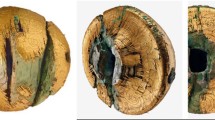Abstract
Throughout history, various band weaving techniques were used to create ribbons, bands or girdles that comprise a specific group in the archaeological evidence of textile artefacts. Quantitatively, tablet weaving is among the main techniques, but there is also evidence for other weaving techniques. For example, rigid heddles were used to create different weave structures and patterns, from simple repp or tabby weaves to complex geometric designs. This contribution examines weaving on a rigid heddle using an experimental approach, with textile finds from the site of Siksälä in Estonia dating from 800 to 1475 AD serving as the basis for archaeological weaving experiments. In addition, a weaving technique called ‘Auleja’ is used to recreate ribbons with geometric colour design. From as early as the tenth century AD, narrow bands play a central role in the textile tradition around the Baltic Sea and a wider area in Scandinavia. Written sources and folk beliefs passed on in oral history tradition, as well as ethnographic comparisons shed light on the production and also on symbolisms connected with the bands and their patterns.
Access this chapter
Tax calculation will be finalised at checkout
Purchases are for personal use only
Similar content being viewed by others
Notes
- 1.
The oldest ‘Auleja’ or pick-up woven band from Northern Europe is from the site Jõuga in eastern Estonia. The fragment has been dated to the late Iron Age c. 800–1225 AD and described as tabby with repp character (Rammo 2014: 112).
References
Anderson E (2003) Tools for textile production from Birka and Hedeby. In: Ambrosiani B (ed.) Excavation in the black earth 1990–1995. Birka Studies volume 8. Birka Project, Stockholm.
Bender Jørgensen L (1986) Forhistoriske textiler i Skandinavien. Det kongelige nordiske oldskriftselskab, København.
Crowfoot E, Pritchard F, Staniland K (1992) Textiles and clothing c.1150–c.1450. Boydell and Brewer, London.
Demant I (2009) Principles for reconstruction of costumes and archaeological textiles. In: Alfaro Giner C, Tellenbach M, Ferrero R (eds) Textiles y museologia. Consejería de Cultura y Deporte, Valencia, p 143–153.
Dixon A (2012) A brief history of the inkle. What, why, when and where. Anne Dixon, Gasthorpe.
Foulkes SJ (2011) Roman rigid heddles: A survey. Archaeological Texiles Newsletter 52:41–47.
Götze A (1908) Brettchenweberei im Altertum. Zeitschrift für Ethnologie 40(4):481–500.
Karlsone A, Vaska B (2009) Sẽnosios Šventinių Drabužuų Puošybos Tradicijos. In: Butrimas A (ed.) Baltu Menas. Art of the Balts. Vilniaus dailė akademija, Vilnius, p 285–372.
Laul S, Valk H (2007) Siksälä, a community at the frontiers. CCC Papers 10. University of Tartu and Gotland University College, Tartu and Tallinn.
Matsin A (2013) The 13th–16th century tablet-woven bands from Estonia. In: Hopkins H (ed.) Ancient textiles, modern science II. Ancient Textiles Series 34. Oxbow Books, Oxford and Oakville, p 64–78.
Neumann R, Freudenberg B, Siwek M (2011) Das Vaaler Bändchen – Die Rekonstruktion eines archäologischen Kammgewebes aus Dithmarschen als Gemeinschaftsarbeit der Wollgruppe des Museumdorfes Düppel in Berlin. Experimentelle Archäologie in Europa Bilanz 10:213–218.
Øye I (1988) Textile equipment and its working environment. Bryggen in Bergen c 1150–1500. The Bryggen Papers Main Series 2. Norwegian University Press, Oslo.
Rammo R (2014) Tradition and transition: The technology and usage of plant-fibre textiles in Estonian rural areas in the 11th–17th centuries. In: Lipkin S, Vaianto K (eds) Focus on archaeological textiles: Multidisclipinary approaches. Monographs of the Archaeological Society of Finland 3, p 102–115.
Rammo R, Matsin A (2014) Weaving in Medieval village on the basis of Siksälä finds. In: Valk H, Laul S (eds) Siksälä Kalme I. Muistis Ja Ajalugu, Tartu Ülikool, Tartu, p 352–351.
Rand P (2019) Estonian pick-up woven belts. Estonian National Museum (ENM), Saara Kirjastus, Tartu.
Schweppe H (1992) Handbuch der Naturfarbstoffe. Vorkommen, Verwendung, Nachweis. Ecomed Verlagsgesellschaft, Landsberg/Lech.
Sperling U (2014) Aspekte des Wandels in der Bronzezeit im Ostbaltikum. Die Siedlung der Asva-Gruppe in Estland. Tallinn Estonian Academic Publishers, Tallinn.
Torgenrud H (2014) Norwegian pick-up bandweaving. Schiffer, Atglen.
Valk H, Laul S (2014) Siksälä Kalme I. Muistis Ja Ajalugu. Tartu Ülikool, Tartu.
Valk H, Ratas J, Laul S (2014) Siksälä Kalme II. Matuste Ja Leidude Kataloog. Tartu Ülikool, Tartu.
Van Groningen JS (1520–1540) Van traktaat over de naaikunst (Titlelblad), Cologne, Rijksmuseum, Amsterdam, https://artsandculture.google.com/culturalinstitute/beta/asset/titelblad-van-traktaat-over-de-naaikunst-jan-swart-van-groningen-willem-vorsterman/UQEuRhpEWPh2Eg, accessed 07 Dec 2020.
Wild JP (1988) Textiles in archaeology. Shire Archaeology, Aylesbury.
Author information
Authors and Affiliations
Editor information
Editors and Affiliations
Rights and permissions
Copyright information
© 2022 The Author(s), under exclusive license to Springer Nature Switzerland AG
About this chapter
Cite this chapter
Lau, R. (2022). Weaving Experiments with the Rigid Heddle: Woven-in Metal Spirals from Siksälä and ‘Auleja’ Technique. In: Ulanowska, A., Grömer, K., Vanden Berghe, I., Öhrman, M. (eds) Ancient Textile Production from an Interdisciplinary Perspective. Interdisciplinary Contributions to Archaeology. Springer, Cham. https://doi.org/10.1007/978-3-030-92170-5_16
Download citation
DOI: https://doi.org/10.1007/978-3-030-92170-5_16
Published:
Publisher Name: Springer, Cham
Print ISBN: 978-3-030-92169-9
Online ISBN: 978-3-030-92170-5
eBook Packages: HistoryHistory (R0)




